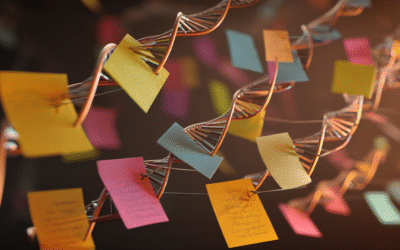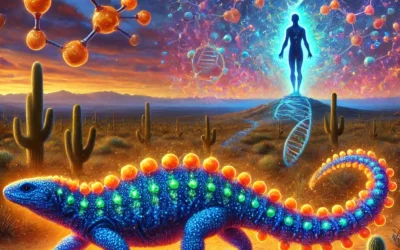In the soft boundary where hard science dissolves into wonder, there exists a fact so quietly astonishing that it seems plucked from science fiction: human bodies emit light. Not as metaphor, not as spiritual allegory, but as measurable physical phenomenon. We are, quite literally, aglow—each of us radiating a faint luminescence imperceptible to the naked eye yet undeniably present, pulsing beneath our skin in rhythmic waves that peak, curiously enough, in the middle of the afternoon.
This revelation—that we humans join fireflies, deep-sea anglerfish, and certain fungi in the elite club of light-emitting organisms—might sound like mysticism dressed in scientific language. But the evidence is unambiguous. We are creatures of light, albeit dim ones, our bodies continuously releasing photons as byproducts of the vast biochemical factory operating within our cells.
The Accidental Luminescence of Being
What separates us from the intentional glow of a firefly’s lantern is both degree and purpose. The firefly’s bioluminescence results from a deliberate enzymatic reaction that produces light as its primary function—an evolutionary adaptation for communication and mating. Our glow, by contrast, is an incidental side effect of metabolism itself—the complex biochemical dance that converts nutrients into energy, builds and repairs tissues, and maintains the delicate homeostasis necessary for life.
At the molecular level, this accidental radiance emerges primarily from oxidative processes occurring within our cells. As mitochondria—those ancient bacterial hitchhikers that now serve as cellular power plants—convert glucose and oxygen into ATP (adenosine triphosphate, the universal energy currency of biological systems), they inevitably generate reactive oxygen species (ROS) as byproducts. These highly reactive molecules can damage cellular components if not properly managed, but they also occasionally interact with various biomolecules in ways that release tiny flashes of light: biophotons.
“The process is somewhat like watching sparks fly off a grinding wheel,” explains Dr. Fritz-Albert Popp, one of the pioneers in biophoton research. “The cellular machinery works with remarkable efficiency, but nothing in nature is perfect. These tiny light emissions represent energy being released during chemical reactions—metabolic friction, if you will.”
Every living organism exhibits this phenomenon to some degree. Plants, bacteria, fungi, and animals all emit biophotons as their cells go about the business of staying alive. But human biophoton emission displays patterns unique to our species, offering a literal window into the rhythms of our biochemistry.
Capturing the Invisible: The 2009 Breakthrough
The definitive demonstration of human bioluminescence came in 2009, when a team led by Hitoshi Okamura at Kyoto University conducted an experiment that sounds deceptively simple: they placed healthy male volunteers in a pitch-black room and photographed them with ultrasensitive cameras capable of detecting single photons.
What makes this experimental design so challenging is the extreme sensitivity required. The photon emissions from human skin are approximately 1,000 times weaker than the threshold of human visual perception. To capture these emissions, Okamura’s team employed photomultiplier technology that could detect light levels one million times fainter than conventional cameras.
The resulting images, published in PLOS ONE, revealed not just that humans emit light, but that this emission follows distinct temporal and spatial patterns. The volunteers’ faces glowed most prominently, particularly the cheeks, forehead, and neck. And rather than remaining constant, the intensity of this glow fluctuated throughout the day in a predictable rhythm: weakest in early morning, steadily increasing until mid-afternoon (peaking around 4 p.m.), then gradually diminishing into evening.
Crucially, this pattern did not correlate with body temperature or infrared radiation, which follow different diurnal curves. Instead, the afternoon peak of photon emission aligns precisely with other well-established biomarkers of metabolic activity.
“What’s remarkable is how tightly synchronized this light emission is with our circadian biology,” notes chronobiologist Martha Merrow of Ludwig Maximilian University. “It’s another layer of evidence that humans are profoundly temporal beings, our biochemistry rising and falling in predictable waves throughout the 24-hour cycle.”
The Geography of Glow
The spatial distribution of human bioluminescence—brightest on the face, particularly the cheeks and forehead—offers intriguing clues about its biological origins. These regions correspond to areas with high microcapillary density, thin skin, and abundant metabolically active tissues. The correlation is hardly coincidental.
The face, through evolutionary pressures related to sensory processing and social signaling, has developed extraordinary metabolic demands. Our facial muscles, perpetually engaged in expression, communication, and environmental monitoring, require robust energy supply. The same applies to our specialized sensory organs—eyes, ears, nose—concentrated in this region. This metabolic intensity translates to higher concentrations of mitochondria, greater oxidative activity, and consequently, more biophoton emission.
What’s particularly fascinating is how this distribution maps onto traditional concepts in various cultural traditions. In Chinese medicine, the face is seen as a diagnostic map reflecting internal organ health. In numerous spiritual traditions, the “third eye” chakra positioned on the forehead is associated with insight and perception. While scientific evidence doesn’t support literal interpretations of these traditions, the coincidence between areas of heightened biophoton emission and culturally significant facial regions raises intriguing questions about how subtle biological phenomena might have influenced cultural perceptions throughout human history.
The Invisible Made Visible: What We Cannot See
Our inability to perceive our own luminescence raises fascinating questions about perception itself. Human vision evolved to detect light within a specific range of intensities and wavelengths—a bandwidth optimized for our ancestors’ survival needs. We can see neither the ultraviolet patterns that guide bees to flowers nor the infrared signatures that allow pit vipers to hunt in darkness. Similarly, our visual systems filter out the faint glow of biophotons, likely because detecting such weak signals would offer no evolutionary advantage while potentially interfering with more useful visual information.
Yet throughout history, various cultures have described seeing “auras” or subtle energetic fields surrounding human bodies. While much of this belongs firmly in the realm of pseudoscience, the demonstrated reality of biophoton emission offers an intriguing possibility: could some individuals with unusual visual sensitivity perceive, at least partially, these emissions?
“The human visual system shows remarkable individual variation,” explains vision researcher Alison Gopnik of UC Berkeley. “Some tetrachromats possess a fourth type of cone cell, allowing them to perceive color distinctions invisible to most people. Certain individuals with aphakia—absence of the eye’s lens—can see ultraviolet light. It’s not entirely implausible that rare individuals might detect extremely faint light emissions that most of us filter out.”
Reports of human aura perception spike in conditions of visual deprivation or altered states of consciousness—precisely the situations where the visual system might become hypersensitive to normally filtered signals. While this doesn’t validate claims of seeing emotional or spiritual energies, it suggests that some perceptual experiences dismissed as purely hallucinatory might contain elements of actual biological phenomena.
Chronobiology: The Afternoon Light Peak
Perhaps the most striking aspect of human bioluminescence is its temporal pattern—the afternoon peak that corresponds precisely with other markers of our circadian biology. This pattern reveals something fundamental about how our bodies operate in time.
The human body is not a static system but a dynamic one, constantly shifting between different metabolic states across the day. Morning hours feature elevated cortisol, preparing us for activity. Mid-afternoon brings peak body temperature, optimal muscle coordination, and heightened cognitive processing speed. Evening sees rising melatonin, preparing us for rest. This orchestrated rhythm, driven by the suprachiasmatic nucleus in the hypothalamus, coordinates thousands of biochemical processes to optimize our function within the day-night cycle.
The afternoon peak in biophoton emission coincides with several other physiological maxima: core body temperature reaches its zenith, cognitive processing speed hits its stride, and physical performance measures (like reaction time and muscle strength) often peak. This convergence is no coincidence—all reflect the heightened metabolic activity programmed into our afternoon biology.
“It’s fascinating to consider that Olympic records are most commonly broken in afternoon competitions,” notes exercise physiologist Timothy Noakes. “Our bodies have evolved to perform at their peak during daylight hours, particularly the latter portion when our ancestors would have been returning from hunting or gathering, preparing food, and engaging in social activities before nightfall.”
This synchronization explains why many cultures developed the tradition of afternoon “siestas” in hot climates—the metabolic peak creates additional body heat that, combined with environmental heat, can create physiological stress. The afternoon rest period evolved not from laziness but as an adaptive response to the convergence of internal and external temperature peaks.
Beyond Human: The Universal Language of Light
While human biophoton emission may seem like a biological curiosity, it connects us to a broader phenomenon spanning all life forms. From bacteria to blue whales, living systems emit photons as an inevitable consequence of metabolism. This universal property suggests something profound about life itself—that the manipulation of energy at the quantum level represents a fundamental signature of biological organization.
In plants, biophoton emissions correlate with photosynthetic activity and stress responses. Injured or diseased plant tissues show altered emission patterns, creating a light-based signature of their condition invisible to human eyes but potentially detectable by specialized organisms. Some fungi may actually use biophoton detection as a form of “vision,” allowing them to navigate toward organic material for decomposition.
Bacterial colonies demonstrate coordinated biophoton emissions that some researchers believe may constitute a primitive form of intercellular communication—a light-based signaling system operating below the threshold of conventional biochemical pathways. In the ocean, bioluminescent organisms have evolved to harness and amplify this basic property into spectacular light shows that serve functions from mating to predation to defense.
Viewed from this perspective, the faint glow of human skin represents our own version of a universal biological phenomenon—a photonic whisper that connects us to the entire tree of life. We are not unique in our luminescence, merely distinctive in its particular patterns and intensities.
Clinical Implications: Reading the Light of Life
Beyond its philosophical intrigue, human biophoton emission offers potential practical applications, particularly in medical diagnostics. Research has shown that disease states alter the intensity and pattern of biophoton emissions. Cancer cells, with their dysregulated metabolism, emit significantly different biophoton signatures than healthy cells. Inflammatory conditions increase emission intensity. Even psychological stress appears to alter the photonic output of human tissue.
“We’re essentially seeing metabolism made visible,” explains biophysicist Roeland Van Wijk of Leiden University. “Any condition that affects cellular energy production—from cancer to diabetes to mitochondrial disorders—should theoretically create detectable changes in biophoton emission patterns.”
Japanese researchers have demonstrated that biophoton emission from the hands increases significantly during qi gong meditation practices, suggesting that certain mental states might influence oxidative metabolism in peripheral tissues. German scientists have documented distinctive changes in emission patterns corresponding to local inflammatory conditions, potentially offering a non-invasive method for monitoring inflammatory diseases.
While current technology for detecting these subtle emissions remains too cumbersome for clinical settings, advances in photonics and quantum sensors may eventually make “biophoton diagnostics” a practical reality—a light-based window into the metabolic state of tissues that complements conventional biomarkers.
The Poetics of Human Light
There is something profoundly moving about the knowledge that we humans, for all our solid-seeming substantiality, are quietly radiant beings. Our bodies—these collections of cells we inhabit—are not merely physical structures but dynamic energy systems, literally glowing with the biochemical processes that constitute life itself.
This scientific fact resonates with metaphors across cultural traditions. In countless spiritual systems, light serves as the primary metaphor for consciousness, wisdom, and life force. From the Hindu concept of “tejas” (inner radiance) to the Christian “light of the world,” from the Buddhist “clear light of mind” to the Jewish “divine spark,” human cultures have intuited a connection between life, consciousness, and luminescence.
Now science confirms a literal truth underlying these metaphorical frameworks: we do indeed glow. Not with the mystical light of consciousness perhaps, but with the tangible photonic evidence of the extraordinary metabolic processes that make consciousness possible.
In the afternoon, when your perception feels sharpest and your energy strongest, pause to consider this remarkable truth: in that moment, invisible to your eyes but measurable by our instruments, your body shines its brightest. The light that no one sees marks the peak of your biological tide, the zenith of your cellular activity.
We are beings woven from matter but animated by energy—walking constellations of atoms engaged in reactions so complex they produce not just movement, thought, and emotion, but actual light. In the most literal sense, there is a brightness to being human—a faint but undeniable luminescence that signals our participation in the grand chemistry of life.
And for a brief window each afternoon, we shine our brightest.



